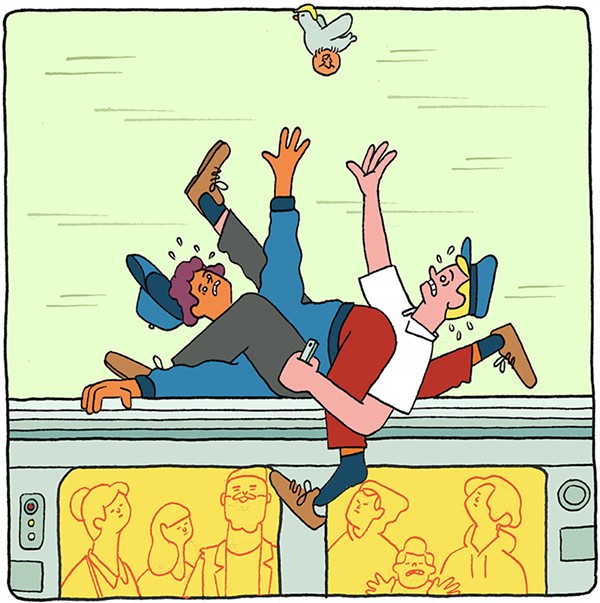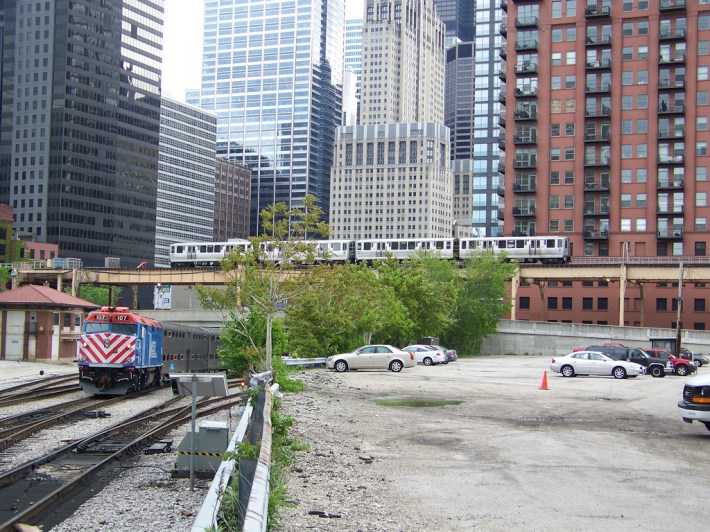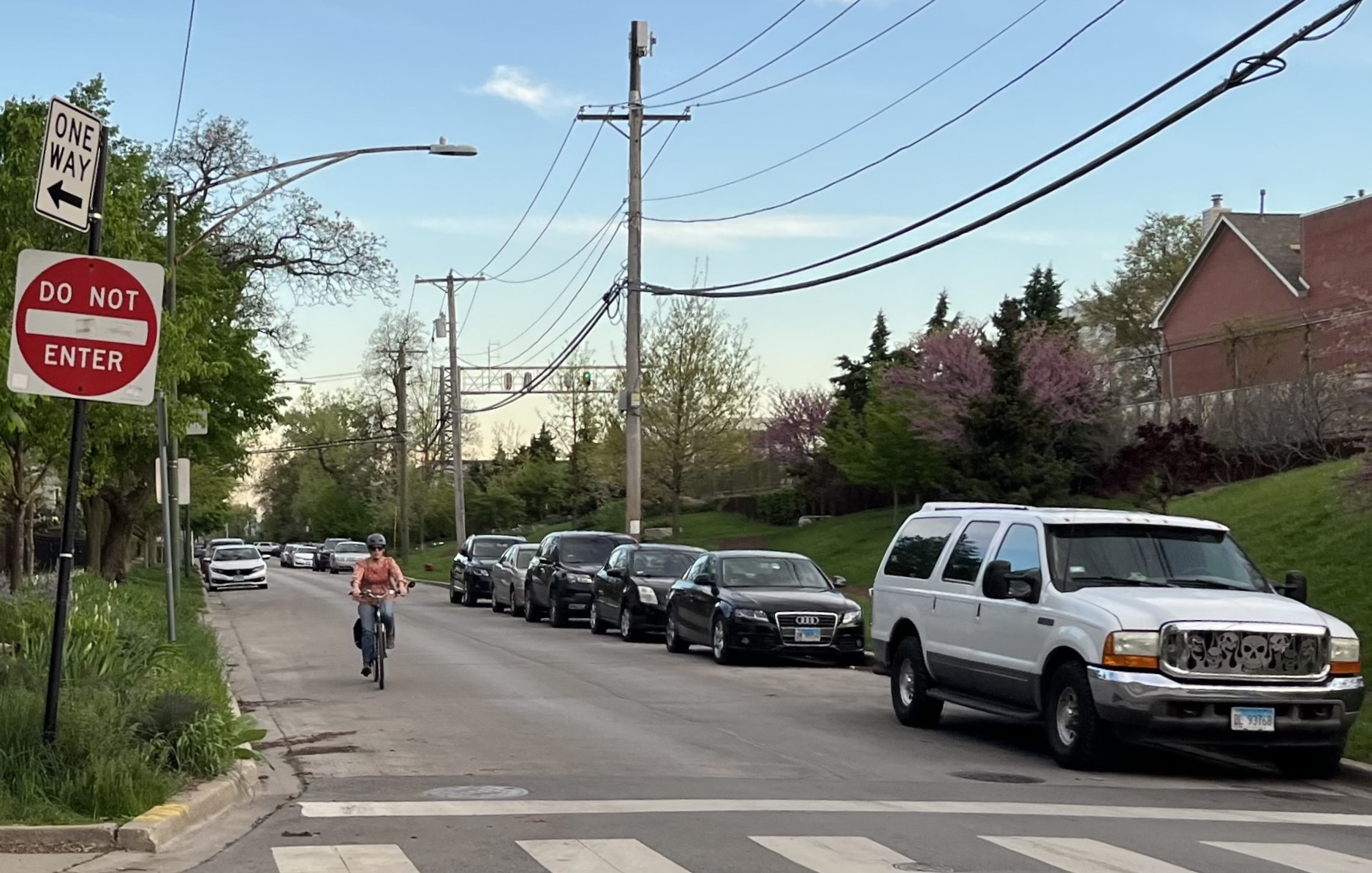Can the CTA and Metra Learn to Play Nice?
2:42 PM CST on February 8, 2018

Illustration: Bobby Sims, Chicago Reader
[Streetsblog Chicago editor John Greenfield publishes a weekly transportation column in the Chicago Reader. We syndicate the column on Streetsblog Chicago after it comes out online.]
On January 26 when Mayor Rahm Emanuel and the CTA unveiled the route for the $2.3 billion extension of the Red Line from 95th Street to 130th Street, the big question was where the heck the money would come from. The city hopes to apply for $1 billion in federal grants for the project. However, the day before the announcement the White House infrastructure advisor stated that Donald Trump’s $200 billion infrastructure bill won’t include any new revenue, but it will involve cuts to transit funding.
For years transit experts and advocates have pushed for a much cheaper, quicker way to bring rapid transit to the far south side. The Metra Electric District route generally parallels the el route and makes many stops in the neighborhoods that would be served by the four Red Line extension stations. Previous estimates have put the cost of converting the MED to frequent service and integrating its fare system with the CTA at under $1 billion. Moreover, the new service could potentially boost transportation access for south siders sooner than the RLE, which wouldn’t be operational until 2026 at the earliest.
In 2016 Emanuel asked the Regional Transit Authority, which oversees the CTA, Metra, and Pace, to launch a conversation on the subject between the agencies. And, as I discussed in this column last week, the Obama Presidential Center plan has recently sparked new interest in rapid Electric service, since the line stops right by the future campus.
But one possible fly in the MED ointment would be the difficulty of coordinating the CTA and Metra on the conversion project. Like the RTA and Pace, each of these transit agencies has its own board of directors, and there’s a widespread view among transit advocates that the CTA and Metra operate in silos, and sometimes compete with each other for funding and riders.
Advocates argue that this separation and rivalry hurts regional transportation in other ways. For example, while you can transfer between CTA buses and trains, plus Pace buses, for a quarter, switching between CTA and Metra generally requires you to pay two full fares. As policy analyst Daniel Kay Hertz noted last year in Chicago Magazine this discourages residents from unlocking the full potential of our city’s 20 total transit rail lines.
So, is sibling rivalry between these sister agencies a real thing and, if so, how can we promote more brotherly love?
Like many parents with arguably unruly kids, the RTA doesn’t think there’s a problem. “We see a cooperative relationship,” said spokeswoman Susan Massel, noting that the CTA, Metra, and Pace collaborated with her organization on the regional transit strategic plan, approved in January. The document states that $30 billion is needed for underfunded transit infrastructure projects in the region, and Massel says all four agencies have committed to working together to lobby for a steady revenue stream of $2-3 billion for capital investments.
Likewise, CTA spokeswoman Catherine Hosinski and Metra spokesman Michael Gillis argued that cooperation between their organizations has never been stronger. They both noted that the agencies teamed up to offer alternative service during the 2013 south Red Line reconstruction, and they honor each other’s monthly passes during unplanned service disruptions.
The spokespeople added that the Loop Link bus rapid transit corridor was created to connect the West Loop Metra stations to Michigan Avenue, and the new Union Station Transit Center eases transfers between CTA buses and Metra trains. They also asserted that the 2015 launch of the Ventra smartphone app, which lets CTA and Metra riders add value to their cards and permits Metra passengers to purchase tickets onboard without a surcharge, is proof that the region already has an integrated fare payment system.
Gillis added that increasing frequency on the Electric line while lowering fares to the CTA rate of $2.50 would be difficult “at a time when we are starved for capital dollars and are struggling to maintain our current level of service with our current operating subsidies.” Last summer's Illinois budget deal included cuts in state funding for the CTA, Metra, and Pace. As a result all three systems raised fares this years and Metra reduced service on some line earlier this month.

But despite Massel, Hosinski, and Gillis’ assurances that the CTA and Metra get along swimmingly, representatives of all three major Chicago transportation advocacy groups
“There are well-documented and systemic governance and financing problems that make the lack of cooperation between transit agencies predictable,” said Active Transportation Alliance executive director Ron Burke. “From the slow journey to a universal fare card, funding decisions not tied to a strategic transit vision for the region, and the inability to convert the Metra Electric into a CTA-style service in Chicago, these shortcomings are a function of systemic problems.” Burke conceded that the situation has improved since 2013, when the Northeast Illinois Public Transit Task Force released a report outlining these issues.
Center for Neighborhood Technology executive director Scott Bernstein noted that the CTA and Metra vie against each other for infrastructure grants from the federal transit administration. “They don’t lobby together and they don’t put in joint applications, so in what way could you say that they aren’t competing in that regard?”
Bernstein said he’d also like to see the RTA, the CTA, and Metra, which each have separate programs to promote transit-oriented development, join forces on this front, which could save money and attract more private-sector investments. He added that teamwork could help them confront the challenge of competition from ride-hailing services, which studies show are cannibalizing transit ridership. “Uber and Lyft are marketing themselves, but we don’t see a concerted marketing effort for public transportation. A couple of billboards along the Kennedy don’t cut it.”
Metropolitan Planning Council director Audrey Wennink noted that in some parts of the region the CTA and Metra compete for a larger cut of local sales tax revenue, as well as customers. In addition to the parallel Red Line and MED, the systems have stations near each other in Oak Park, Evanston, plus other locations, so often riders’ decisions are based on whether they want or need frequent and cheap service (the el) or shorter travel times (Metra.)
Wennink added that it’s understandable that the agencies are dragging their feet about pursuing real fare integration, as opposed to merely sharing the Ventra app. “If a rider who transfers from Metra to CTA only has to pay a small transfer fee and not the full CTA fare, as is the case now, who absorbs that loss in revenue?” she asked. “That said, further fare integration still is needed and the riders really want it. It’s a state requirement that’s not being fully met.”
But one thing the agencies and the advocates agree on is that much of the competition that does exist between the CTA and Metra is due to a factor beyond their direct control: the lack of adequate investment in transit. “The funding pie needs to be bigger so we are both adequately funded,” Gillis said.
Wennink added that to make this happen, Illinois lawmakers probably need to raise the state gas tax, which has been stuck at 19 cents a gallon since 1990, and/or vehicle registration fee. She said they should also consider long-term solutions like a distance-based driving tax, since the increasing popularity of hybrid and electric vehicles means that cars will be burning less gasoline in the future, and thus the gas tax will generate less revenue. “Ultimately, if the transit agencies were not so underfunded and not fighting for their lives, they might have more capacity to think creatively.”
In addition to editing Streetsblog Chicago, John writes about transportation and other topics for additional local publications. A Chicagoan since 1989, he enjoys exploring the city on foot, bike, bus, and 'L' train.
Stay in touch
Sign up for our free newsletter
More from Streetsblog Chicago
Due to incredible support from readers like you, we’ve surpassed our 2023-24 fundraising goal
Once again, the generosity of walk/bike/transit boosters is fueling our reporting and advocacy.
Which Metra corridor would become more bike-friendly and greener under a new plan? Ravenswood!
Thanks to plans to convert little-used parking spaces, the avenue is slated to get a new bike lane, and the Winnslie Parkway path and garden will be extended south.
They can drive 25: At committee meeting residents, panelist support lowering Chicago’s default speed limit
While there's no ordinance yet, the next steps are to draft one, take a committee vote and, if it passes, put it before the full City Council.



